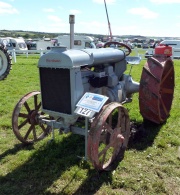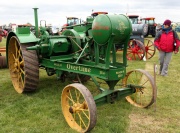Fordson: Model F


















Note: This is a sub-section of Fordson: Tractors.
- 1917-1928 Produced in Dearbon
- 1919-1922 produced in Cork
The Fordson Model F was completed in 1916 and was the first lightweight, mass produced tractor in the world, making it possible for the average farmer to own a tractor for the first time.
Ford incorporated his private company, Henry Ford and Son, Inc, to mass produce the tractor on July 27, 1917. At a hurriedly built factory in Dearborn, Michigan, he used the same assembly line techniques he used to mass produce the Ford Model T. It took thirty hours and forty minutes to convert the raw materials into the 4,000 parts used for the tractor assembly
It used a 20 horsepower, four-cylinder vaporising oil engine, a three-speed spur gear transmission (the three forward speeds ranged from approximately 2.25 to 6.25 mph), and a worm gear reduction set in the differential. Brakes were not provided on early Fordsons as high-ratio worm sets generally transmitted rotation in one direction only, from the worm element to the gear element, because of the high power loss through friction. To stop the tractor, the driver depressed the clutch. Ford engineer Eugene Farkas successfully made the engine, transmission and rear axle a stressed member of the frame. By eliminating the need for a heavy separate frame, costs were reduced and manufacturing was simplified
Ford started shipping Fordson tractors to Ford Motor Company Limited in Britain in 1917 to meet an order from the British government for 5,000 tractors. Between the time the order was accepted and when production started, Ford overhauled the design to solve several problems. The car-type radiator was increased in size so that its capacity was eleven gallons to cure overheating problems. The additional weight also helped hold the front down.
In early Fordsons, the worm drive was located at the top under the driver's seat. During heavy operation the heat became unbearable to the operator. The worm drive was relocated to solve this problem and also allowed larger rear wheels which improved traction. Several changes were also made to simplify manufacture. The Fordson used the Model T coil magneto system; and water and oil pumps were eliminated in favour of the simpler thermosiphon cooling and splash lubrication
See Also
Sources of Information
- [1] Wikipedia

